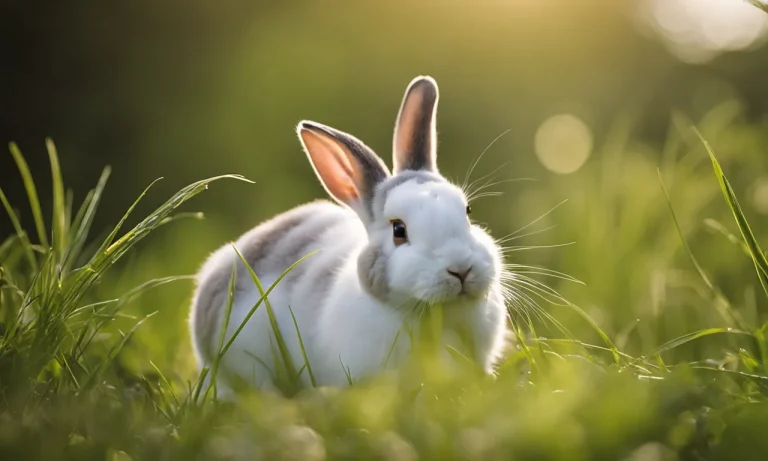Mountain goats are amazing climbers that can scale nearly vertical cliffs and rocky slopes with ease. If you’ve seen photos or videos of mountain goats perched on tiny ledges on the side of steep mountains, you may have wondered, how do they not fall off?
Well, here’s a quick answer: Mountain goats have specialized hooves and legs that allow them to grip rock surfaces securely. They’re also excellent at balancing and judging distances. Throughout this article, we’ll explore mountain goats’ anatomy and behavior in depth to understand how they’re such expert climbers.
Anatomy Adaptations That Help Mountain Goats Climb
Mountain goats are incredibly skilled climbers, able to navigate steep cliffs and rocky terrain with ease. Their ability to maintain balance and avoid falling off cliffs is due to a variety of anatomical adaptations that help them in their mountainous habitats.
Hooves Provide Traction and Support
One of the key adaptations of mountain goats is their specialized hooves. Their hooves have a unique structure that allows them to grip onto rocks and rough surfaces, providing them with excellent traction.
The outer edges of their hooves are made up of hard keratin, which helps to prevent slipping and sliding on steep inclines. Additionally, the underside of their hooves is lined with rubbery pads, which act as shock absorbers and provide extra grip.
The hooves of mountain goats are also flexible, allowing them to adjust their grip depending on the surface they are navigating. This flexibility enables them to maintain stability even on uneven or slippery terrain.
Flexible Ankles and Powerful Legs
Mountain goats have incredibly strong and muscular legs, which allow them to leap and bound across rugged terrain. Their legs are also equipped with flexible ankle joints, which provide them with a wide range of motion.
This flexibility enables them to easily adjust their footing and maintain balance while climbing steep slopes or traversing narrow ledges.
With their powerful legs, mountain goats can jump up to 12 feet horizontally and 6 feet vertically in a single leap. This impressive jumping ability allows them to navigate gaps and obstacles in their path, ensuring they can continue their ascent without difficulty.
Low Center of Gravity
Another adaptation that helps mountain goats maintain their balance is their low center of gravity. Their bodies are compact and muscular, which helps to distribute their weight evenly and keeps them stable on uneven surfaces.
This low center of gravity allows them to make quick and agile movements without losing their balance.
Furthermore, the horns of mountain goats play a role in their balance and stability. Their horns act as counterweights, helping to offset the weight of their bodies and keeping them upright. The horns also provide additional support when climbing by allowing the goats to brace themselves against rocks and ledges.
Behaviors and Senses That Keep Mountain Goats Balanced
Careful Stepping
One of the main reasons why mountain goats are able to navigate steep cliffs without falling off is their careful stepping. These incredible animals have adapted to life in rocky, uneven terrains by developing specialized hooves.
Their hooves are equipped with soft pads and rough, rubber-like soles that provide them with excellent traction. This allows them to grip onto the smallest ledges and narrowest crevices, giving them the stability they need to move confidently along the mountainside.
Additionally, their hooves have sharp, curved dewclaws that act like crampons, providing even more grip on slippery surfaces.
Keen Spatial Awareness
Mountain goats possess a remarkable sense of spatial awareness, which helps them maintain their balance while navigating treacherous cliffs. They have an exceptional ability to judge distances and heights, allowing them to make precise leaps and landings.
Their keen eyesight plays a crucial role in this, as they are able to spot footholds and potential dangers from afar. This heightened sense of awareness helps them avoid unstable areas and select the safest and most secure paths along the steep slopes.
Caution on Descents
When it comes to descending steep cliffs, mountain goats exhibit a cautious approach. They carefully assess the terrain before making any moves and take their time to plan their descent. Their muscular body structure allows them to control their movements with great precision.
They lower their center of gravity, bending their front knees and extending their hind legs, which helps them maintain stability and prevent toppling over. By descending in a slow and deliberate manner, mountain goats minimize the risk of slipping or losing their balance.
Where Mountain Goats Live and Their Climbing Habits
Mountain goats are known for their impressive climbing abilities and surefootedness on steep cliffs and rocky terrains. They are primarily found in rocky mountain habitats, where they have adapted to survive in extreme conditions.
These habitats provide the perfect environment for mountain goats to showcase their remarkable climbing skills.
Rocky Mountain Habitats
Mountain goats are commonly found in the Rocky Mountains of North America, where they inhabit rugged slopes, cliffs, and alpine meadows. These regions offer the goats the necessary vertical landscapes they need to navigate and thrive.
The rocky terrain provides them with ample opportunities to scale cliffs and mountainsides with ease.
One of the reasons mountain goats can live in these rocky habitats is their uniquely designed hooves. Their hooves have a hard outer shell and a soft, rubbery inner pad that provides them with excellent traction and grip on rocky surfaces.
This adaptation allows them to cling to sheer cliffs and traverse narrow ledges that would be impossible for most other animals.
Foraging at High Elevations
Mountain goats are herbivores and rely on their ability to climb to access their food sources. They are known to forage at high elevations, where vegetation is more abundant and less accessible to potential predators.
This strategy allows them to find nutrient-rich plants that other animals cannot reach.
These agile climbers are able to navigate steep slopes and rocky terrains to reach the alpine meadows and grassy areas where they can graze. Their ability to efficiently climb and descend these challenging landscapes enables them to find food in areas that would be inaccessible to most other animals.
Sleeping on Ledges
Mountain goats have another fascinating behavior that helps them survive in their rocky habitats. They are known to sleep and rest on narrow ledges, sometimes at dizzying heights. This behavior not only keeps them safe from potential predators but also allows them to conserve energy and stay hidden during the day.
While sleeping on a ledge might seem precarious to us, mountain goats have evolved specialized adaptations that make it possible. Their strong muscles and flexible joints allow them to balance and stabilize themselves on these narrow perches, ensuring they don’t fall off cliffs while they rest.
In addition, their exceptional eyesight and keen sense of hearing help them detect any potential threats, allowing them to react quickly and move to safety if needed.
Dangers and Limitations of Mountain Goats’ Climbing
Mountain goats are known for their incredible climbing abilities, effortlessly scaling steep cliffs and navigating treacherous terrains. However, their climbing prowess does not make them invincible. These agile creatures face a number of dangers and limitations as they traverse the rugged mountain landscapes.
Risk of Falling
While mountain goats may appear to defy gravity, they are not immune to the risk of falling. The steep cliffs they call home can be unforgiving, and a misstep could have dire consequences. Despite their surefootedness, accidents do happen, especially during extreme weather conditions or when navigating unfamiliar terrain.
However, mountain goats have adapted to minimize the risk of falling by having sharp hooves with rubbery padding that provides excellent traction on rocky surfaces.
Energy Expenditure
Climbing steep slopes and negotiating rugged terrains requires a tremendous amount of energy. Mountain goats have evolved to be highly efficient climbers, but even so, their climbing activities demand a significant expenditure of energy.
To conserve energy, mountain goats have adapted to have a slower metabolic rate compared to other mammals of similar size. Additionally, they have specialized digestive systems that allow them to extract maximum nutrients from their diet of grasses, leaves, and shrubs found in the mountains.
Competition for Forage
Mountain goats not only have to contend with the physical challenges of climbing, but they also face competition for limited food resources. In mountainous habitats, vegetation can be sparse and patchy, making it a challenge for mountain goats to find enough food to sustain themselves.
They often have to venture to higher elevations or search for new foraging areas to meet their dietary needs. This competition for forage can lead to conflicts among mountain goats, as they defend their territories and access to food sources.
Conclusion
In conclusion, mountain goats have several key adaptations, including specialized hooves, flexible ankles, strong legs, excellent balance, and spatial awareness that allow them to climb mountainous cliffs and slopes with agility.
While they are amazing climbers, mountain goats still face risks like falling, high energy expenditure, and competition for sparse vegetation at high elevations. Their climbing skills enable mountain goats to thrive in steep, rocky habitats that would be difficult for other animals to navigate.






